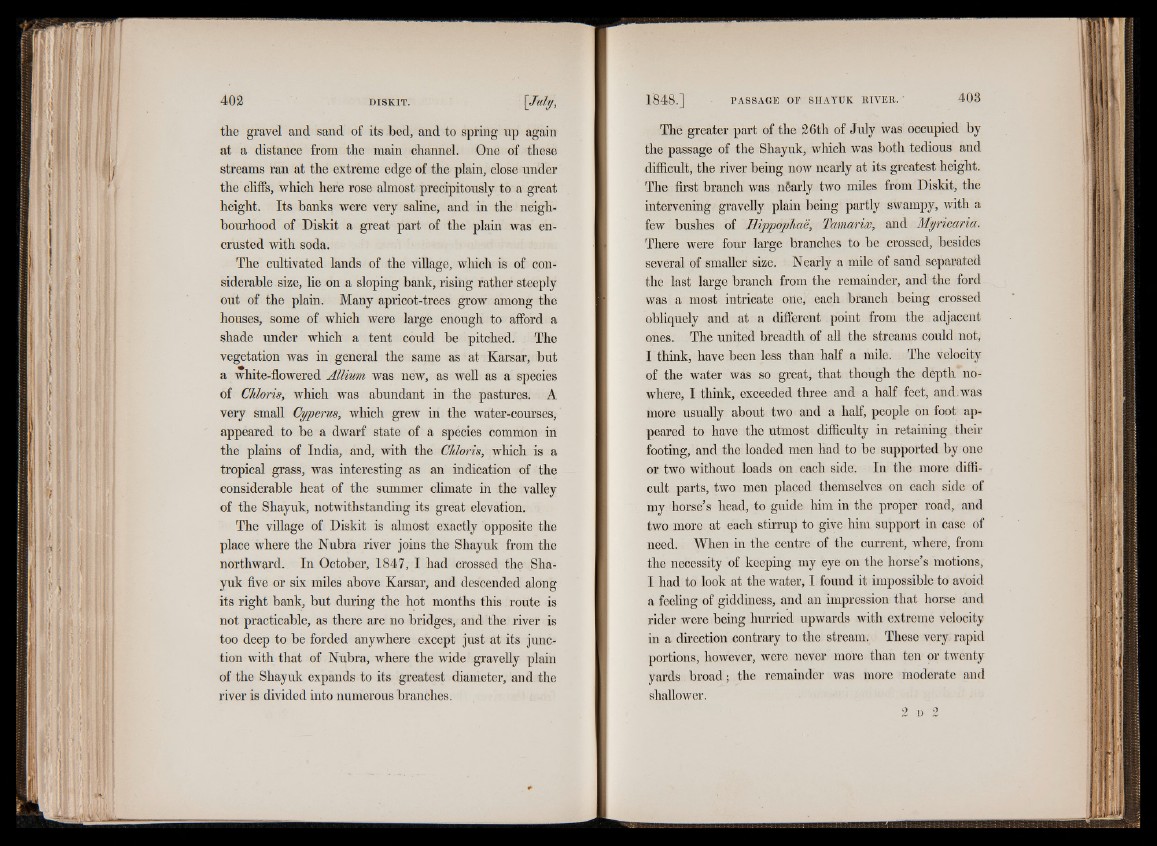
the gravel and sand of its bed, and to spring up again
at a distance from the main channel. One of these
streams ran at the extreme edge of the plain, close under
the cliffs, which here rose almost precipitously to a great
height. Its banks were very saline, and in the neighbourhood
of Diskit a great part of the plain was encrusted
with soda.
The cultivated lands of the village, which is of considerable
size, he on a sloping bank, rising rather steeply
out of the plain. Many apricot-trees grow among the
houses, some of which were large enough to afford a
shade under which a tent could be pitched. The
vegetation was in general the same as at Karsar, but
a white-flowered Allium was new, as well as a species
of Chloris, which was abundant in the pastures. A
very small Cyperus, which grew in the water-courses,
appeared to be a dwarf state of a species common in
the plains of India, and, with the Chloris, which is a
tropical grass, was interesting as an indication of the
considerable heat of the summer climate in the valley
of the Shayuk, notwithstanding its great elevation.
The village of Diskit is almost exactly opposite the
place where the Nubra river joins the Shayuk from the
northward. In October, 1847, I had crossed the Shayuk
five or six miles above Karsar, and descended along
its right bank, but during the hot months this route is
not practicable, as there are no bridges, and the river is
too deep to be forded anywhere except just at its junction
with that of Nubra, where the wide gravelly plain
of the Shayuk expands to its greatest diameter, and the
river is divided into numerous branches.
The greater part of the 26th of July was occupied by
the passage of the Shayuk, which was both tedious and
difficult, the river being now nearly at its greatest height.
The first branch was nearly two miles from Diskit, the
intervening gravelly plain being partly swampy, with a
few bushes of Hippophae, Tamarix, and Myricaria.
There were four large branches to be crossed, besides
several of smaller size. Nearly a mile of sand separated
the last large branch from the remainder, and the ford
was a most intricate one, each branch being crossed
obliquely and at a different point from the adjacent
ones. The united breadth of all the streams could not,
I think, have been less than half a mile. The velocity
of the water was so great, that though the depth nowhere,
I think, exceeded three and a half feet, and. was
more usually about two and a half, people on foot appeared
to have the utmost difficulty in retaining their
footing, and the loaded men had to be supported by one
or two without loads on each side. In the more difficult
parts, two men placed themselves on each side of
my horse’s head, to guide him in the proper road, and
two more at each stirrup to give him support in case of
need. When in the centre of the current, where, from
the necessity of keeping my eye on the horse’s motions,
I had to look at the water, I found it impossible to avoid
a feeling of giddiness, and an impression that horse and
rider were being hurried upwards with extreme velocity
in a direction contrary to the stream. These very rapid
portions, however, were never more than ten or twenty
yards broad; the remainder was more moderate and
shallower.
2 d 2